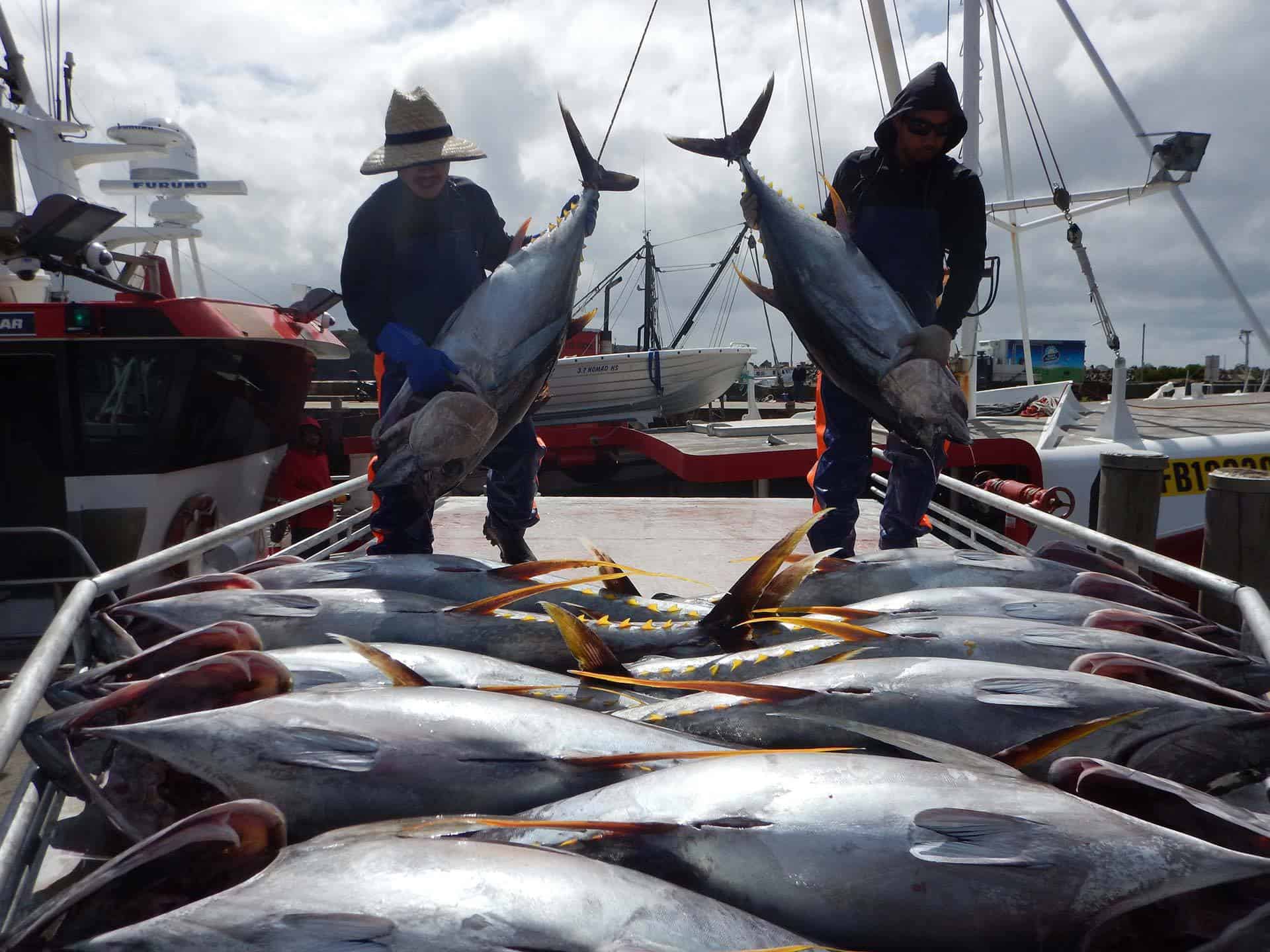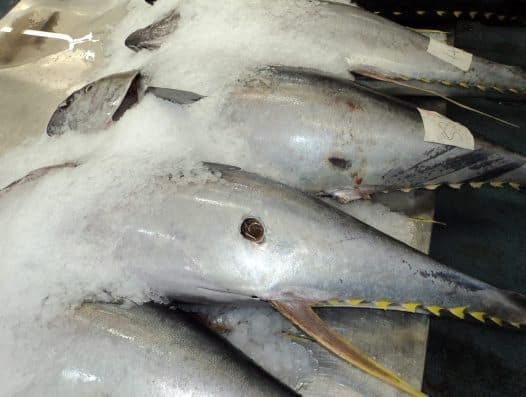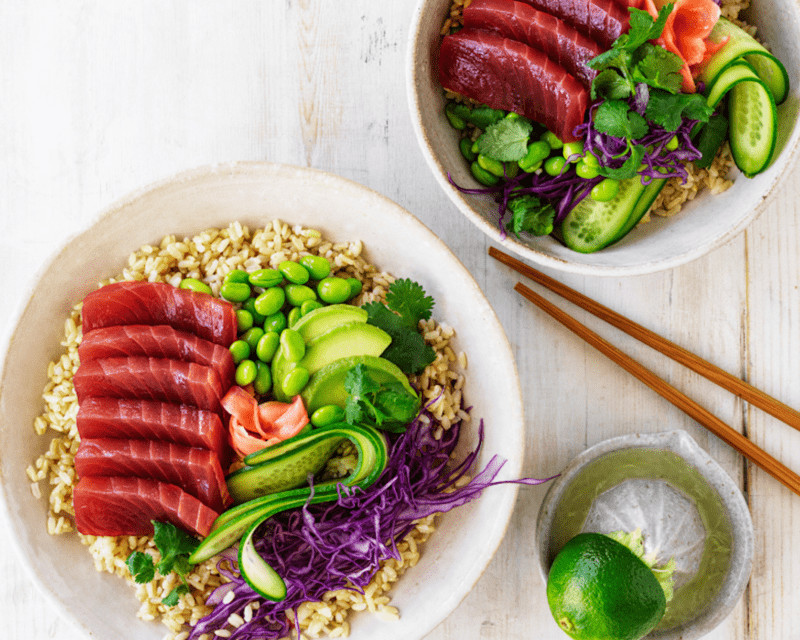11 common questions people ask when seeing a tuna boat being unloaded
For most people, seeing 150 kg swordfish or 60 kg tuna being unloaded from a commercial tuna longliner is a fascinating sight. And often, people start peppering the boat workers with lots of questions—Where was the fish caught? Where will they be sold? How should tuna be cooked? Here, we answer the most commonly asked questions to keep you up to speed with how the tuna industry catches, processes, and sells fish.
1. How far out do tuna boats go to catch fish?
It varies. Boats might travel out just over the continental shelf (50–60 km) or north or west of Lord Howe Island, which could be up to 500 km away from the port. It depends on the time of the year, what fish they are targeting, and where they are. Unlike trawlers that fish the same local grounds each day, tuna longline boats follow the currents, surface height anomalies, and temperature breaks. To give a sense of how far the boats go, it takes 12 hours to travel 185 km i.e., 15kms/hr.
2. Where does the tuna go once unloaded from the boat? How quickly does it reach markets?
Most Tuna Australia members export the majority of their catch to overseas markets such as Japan, the United States, and/or Europe. In addition, members will ship product to various capital cities in Australia (e.g., Melbourne and Sydney) to be sold wholesale or auctioned in the markets, while retaining some fish for local markets (e.g., for the fish co-op in the place where the boat was unloaded).
Generally, the fish is processed and transported to market very quickly. For example, a fish unloaded at Coffs Harbour wharf at 9 am will be available to buy in the local co-op within two hours, reach Sydney markets that night, and reach a wholesale marketer in Japan or the United States the following night.

Unloading tuna.
3. How do tuna producers decide which market the fish goes to?
Every fish is individually graded based on meat colour, fat content, quality, and freshness. The fish are then sent to different markets depending on the characteristics of the fish. It’s like with beef—you get top-end beef in fancy restaurants and cheaper beef in the supermarkets.
The grades and price of grades vary a lot, so tuna producers often split up their product to get the best return. For instance, they might send sashimi-grade bigeye tuna to Japan, small yellowfin tuna to Melbourne, and large yellowfin tuna to top-end restaurants in Sydney and Los Angeles.
4. How many days do tuna boats go out during a single trip?
The exact number of days depends on the boat. Some boats, like those fishing the shelf break, will spend 4–5 days at sea, while boats fishing in the Coral Sea or near Lord Howe Island might go out for up to 14 days.
5. How much do tuna longline boats move around?
The boats fish where they need to. Because they are following the currents and temperature breaks, boats can move around a lot. For example, boats from Ulladulla move up and down the coast to locate water conditions likely to hold good numbers of fish. Their fishing range could be from Coffs Harbour in the north to Eden in the south.

Wounds inflicted by a cookiecutter shark on a yellowfin tuna. Photo by Kevin Rowling.
6. What are those small round bites in the body of the fish?
The bites are from a cookiecutter shark, which goes up to the fish and takes a bite out of them. The bottom jaw of the cookiecutter shark moves and the top jaw is fixed, which results in a bite that is a perfect circle in shape, like that of a cookie-cutter instrument you might find in your kitchen.
7. Why are all the fish in bags?
The fish are individually bagged on the boat. The bags help to protect the fish from rubbing against each other in the chiller tanks. Using bags helps to maintain the quality of the fish and are removed once the fish are taken out of the tanks on the wharf.
8. Is this a foreign boat catching our fish?
No, Tuna Australia member boats are Australian owned. However, some businesses employ skilled workers from overseas as skilled Australian workers are difficult to find.
9. What is each fish worth?
A tuna might weigh 40–50 kg and can be worth up to AUD $20/kg, so that amounts to AUD $800–1,000 per tuna. For other species, like mahi mahi, fishers can receive up to AUD $100-$200 per fish. It is important to remember there are a lot of costs to catch fish.

Easy-as Australian tuna poke bowl. Photo by Great Australian Seafood.
10. What are some ways to cook tuna?
Tuna is a really versatile fish, so it can be cooked by grilling, barbecuing, baking, smoking, poaching, or marinating. It’s also delicious when eaten raw as sashimi.
Here are some fresh tuna recipes that you might wish to try:
- Korean-style tuna tartare (by Neil Perry)
- Easy-as fresh Australian tuna poke bowl
- Kombu-cured yellowfin tuna with yuzu koshu dressing and toasted buckwheat
- One-pot Croatian fish stew (brudet)
- Saucy seafood hotpot (frutta di mare)
11. How are fish processed at sea?
The quality of the tuna meat is related to how efficiently the fish is processed at sea. Fish are slaughtered efficiently and humanely, using a method recognized by leading chefs such as Kylie Kwong as the best way to maintain the quality of the meat. Once processed, the fish is then bagged and placed in a saltwater brine tank or ice slurry to bring the temperature of the fish down below 0°C. This whole process takes 2-3 minutes and ensures premium quality and preservation of the fish.